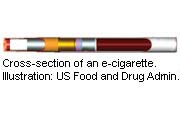
THURSDAY, Sept. 5 (HealthDay News) — The use of electronic cigarettes — or e-cigarettes — by U.S. middle and high school students more than doubled from 2011 to 2012, federal health officials reported Thursday.
And, rather than using electronic cigarettes as a substitute for tobacco, 76 percent of young e-cigarette users also smoked regular cigarettes, according to the U.S. Centers for Disease Control and Prevention.
“Much to our alarm, our children in high school and junior high are experimenting with e-cigarettes at an alarming increase from one year to another,” said Dr. Tim McAfee, director of CDC’s Office on Smoking and Health.
McAfee said the growing use of e-cigarettes by children is troubling, and must be looked at in the context of all tobacco use. “The use of e-cigarettes is not happening in a vacuum, but in a world where cigarettes are ubiquitous. We still have over 40 million people who smoke and 500,000 deaths a year from smoking cigarettes,” he said.
One of the dangers of e-cigarettes is they may encourage children to try real cigarettes, McAfee said. “They [e-cigarettes] are easy to buy because their sale is not restricted,” he said. “They can be sold anywhere, you can buy them over the Internet or at a kiosk in a mall.”
McAfee said a teen who tries even one real cigarette is doubling his or her chances of becoming a smoker. “We are worried that e-cigarettes will help kids overcome their inhibitions and re-normalize smoking and undermine the progress we have made,” he said.
There’s no hard evidence that e-cigarettes lead to smoking real cigarettes, McAfee acknowledged. “Because we are just getting results of surveys we do not have direct evidence, but it’s likely to increase the risk of smoking,” he said.
“There is no upside to teens being exposed to e-cigarettes,” he added.
McAfee said he’s concerned that e-cigarettes will addict children to nicotine at a time when their brains are still developing. “We are worried about the adolescent use of nicotine, because the adolescent brain is uniquely susceptible to addiction and nicotine is harmful to their brain development,” he explained.
The study findings were published in the Sept. 6 issue of the CDC journal Morbidity and Mortality Weekly Report.
Matthew Myers, president of the Campaign for Tobacco-Free Kids, called the CDC findings “alarming, but not surprising.”
“E-cigarettes are sold in an assortment of sweet, kid-friendly flavors including ‘vivid vanilla,’ ‘cherry crush’ and chocolate, and they increasingly are marketed using themes and images long used to market regular cigarettes to kids,” he said.
Although e-cigarette manufacturers contend that they only market to existing smokers, often as a way to quit the habit, the new CDC statistics show the marketing is enticing children to start what could become a lifelong addiction to tobacco products, Myers said.
“The e-cigarette industry portrays itself as wanting to help solve the tobacco problem, but its marketing is reminiscent of the tobacco industry in its worst days,” he pointed out.
Using data from the National Youth Tobacco Survey, the CDC study found that the use of e-cigarettes by high school students rose from 4.7 percent in 2011 to 10 percent in 2012.
The percentage of high school students who said they’d used e-cigarettes in the past 30 days rose from 1.5 percent to 2.8 percent over the same time span. E-cigarette use also doubled among middle school students, the investigators found.
More than 1.78 million middle and high school students had tried e-cigarettes by 2012, the study authors noted.
“The increased use of e-cigarettes by teens is deeply troubling,” CDC director Dr. Thomas Frieden said in an agency news release. “Nicotine is a highly addictive drug. Many teens who start with e-cigarettes may be condemned to struggling with a lifelong addiction to nicotine and conventional cigarettes.”
E-cigarettes are battery-powered devices that deliver a nicotine dose along with other additives. They are not currently regulated by the U.S. Food and Drug Administration. The FDA has said it intends to expand its authority over tobacco products, including e-cigarettes.
According to the FDA, some e-cigarettes have been marketed as smoking-cessation aids, but there’s no scientific evidence that they help people quit smoking.
Thomas Kiklas, president of the Tobacco Vapor Electronic Cigarette Association, an industry group, said e-cigarettes should be regulated in the same way that real ones are, but the FDA has so far not proposed any regulation. A federal court ruled in 2010 that e-cigarettes could not be regulated as a drug or therapeutic device, but could be regulated by the FDA as a tobacco product, he said.
“It is the position of the Tobacco Vapor Electronic Cigarette Association that electronic cigarettes are a tobacco product and, as such, all sales by retailers adhere to all state, local and federal laws/codes pertaining to sales of tobacco products to minors,” Kiklas said. “Electronic cigarettes should not be sold or marketed to minors.”
More information
For more on quitting smoking, visit the U.S. Centers for Disease Control and Prevention.
Copyright © 2025 HealthDay. All rights reserved.

